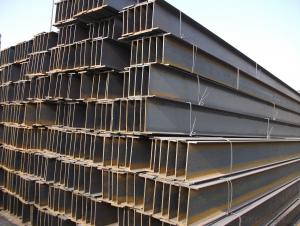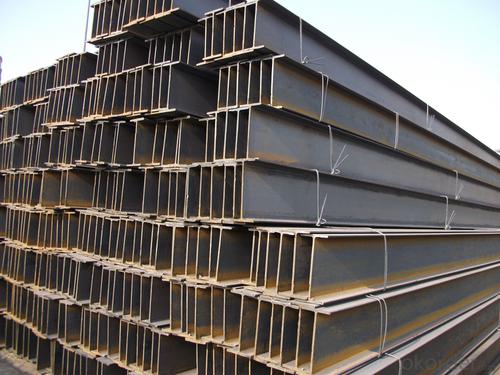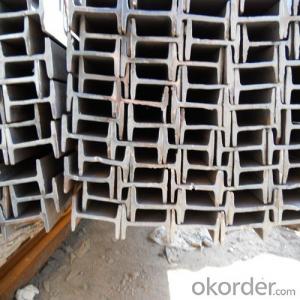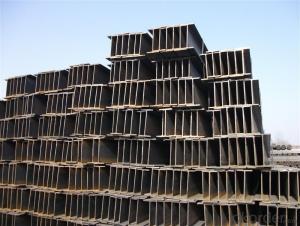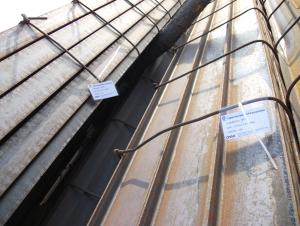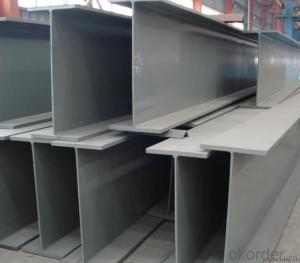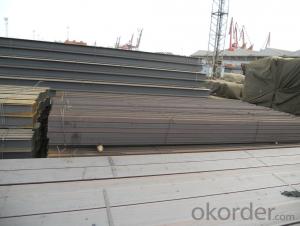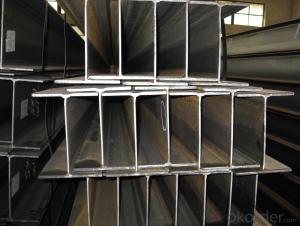Hot Rolled HBeam Steel for Building Structures
- Loading Port:
- Shanghai
- Payment Terms:
- TT OR LC
- Min Order Qty:
- 2000 m.t.
- Supply Capability:
- 10000 m.t./month
OKorder Service Pledge
OKorder Financial Service
You Might Also Like
Product Description:
Specifications of Hot Rolled H-Beam Steel for Building Structures
1. Standard: JIS G3101, SS400(1987),GB700-88, Q235B,EN10034-1993 / EN10025-2004,
HEA100-HEA500,HEB100-HEB500
2. Grade: Q235, SS400 or Equivalent
3. Length: 6m,10m, 12m as following table
4. Invoicing on theoretical weight or actual weight as customer request
5.Payment: TT or L/C
6. Sizes:
SIZE(mm) | DIMENSION (kg/m) |
100*100 | 16.9 |
125*125 | 23.6 |
150*75 | 14 |
150*150 | 31.1 |
148*100 | 20.7 |
198*99 | 17.8 |
200*100 | 20.9 |
248*124 | 25.1 |
250*125 | 29 |
300*150 | 36.7 |
298*149 | 32 |
200*200 | 49.9 |
294*200 | 55.8 |
346*174 | 41.2 |
350*175 | 49.4 |
244*175 | 43.6 |
175*175 | 40.4 |
294*200 | 55.8 |
298*201 | 64.4 |
346*174 | 41.2 |
350*175 | 49.4 |
400*200 | 65.4 |
396*199 | 56.1 |
450*200 | 74.9 |
446*199 | 65.1 |
340*250 | 78.1 |
500*200 | 88.1 |
300*150 | 36.7 |
Usage & Applications of Hot Rolled H-Beam Steel for Building Structures
Commercial building structure ;Pre-engineered buildings; Machinery support structure; Prefabricated structure; Medium scale bridges; Ship-building structure. etc.
Packaging & Delivery of Hot Rolled H-Beam Steel for Building Structures
1. Packing: it is nude packed in bundles by steel wire rod
2. Bundle weight: not more than 3.5MT for bulk vessel; less than 3 MT for container load
3. Marks:
Color marking: There will be color marking on both end of the bundle for the cargo delivered by bulk vessel. That makes it easily to distinguish at the destination port.
Tag mark: there will be tag mark tied up on the bundles. The information usually including supplier logo and name, product name, made in China, shipping marks and other information request by the customer.
If loading by container the marking is not needed, but we will prepare it as customer request.
4. Transportation: the goods are delivered by truck from mill to loading port, the maximum quantity can be loaded is around 40MTs by each truck. If the order quantity cannot reach the full truck loaded, the transportation cost per ton will be little higher than full load.
5. Delivered by container or bulk vessel
Production flow of Hot Rolled H-Beam Steel for Building Structures
Material prepare (billet) —heat up—rough rolling—precision rolling—cooling—packing—storage and transportation
- Q: Can steel H-beams be used for educational buildings?
- Yes, steel H-beams can be used for educational buildings. Steel H-beams are commonly used in construction due to their strength, durability, and load-bearing capabilities. They provide structural support and can be used to create large open spaces, making them suitable for educational buildings such as schools, colleges, or universities. Additionally, steel H-beams are fire-resistant and have high seismic resistance, making them a safe and reliable choice for educational structures.
- Q: Can steel H-beams be used in the construction of museums and art galleries?
- Certainly, museums and art galleries can indeed utilize steel H-beams in their construction. Renowned for their robustness and longevity, steel H-beams possess the capability to bear substantial loads and endure structural strains, rendering them suitable for this purpose. These beams offer exceptional structural support, facilitating the creation of spacious areas and flexible layouts within the museum or art gallery. Additionally, steel H-beams can be tailored to various dimensions and lengths, providing flexibility in terms of design and construction. Furthermore, the sleek and contemporary appearance of steel beams can harmonize with the overall architectural style and design of the museum or art gallery. Overall, owing to their strength, durability, and versatility, steel H-beams are widely favored within the construction industry as an ideal material for museums and art galleries.
- Q: Can steel H-beams be used for hospitals?
- Yes, steel H-beams can be used for hospitals. Steel H-beams are commonly used in construction projects, including hospitals, due to their strength, durability, and ability to withstand heavy loads. They provide structural support and are often used for framing, foundations, and in the construction of floors and ceilings. Additionally, steel H-beams can be easily customized and fabricated to meet the specific needs and requirements of hospital buildings. Overall, steel H-beams are a reliable and practical choice for hospitals and are widely used in the construction industry for various applications.
- Q: Can steel H-beams be used for agricultural buildings?
- Yes, steel H-beams can be used for agricultural buildings. Steel H-beams are commonly used in construction due to their strength, durability, and versatility. They can provide excellent structural support for agricultural buildings such as barns, sheds, or storage facilities. Steel H-beams can withstand heavy loads and provide resistance against weather elements such as wind, snow, and rain. Additionally, steel is a non-combustible material, making it a safer choice for agricultural buildings. The flexibility of steel allows for various design options and modifications to meet specific agricultural needs. Overall, steel H-beams are a reliable and efficient choice for constructing sturdy agricultural buildings.
- Q: How do steel H-beams perform in areas with high humidity and chemical exposure?
- Steel H-beams are renowned for their exceptional strength and durability, making them a popular choice for various structural applications. However, when it comes to regions with high humidity and chemical exposure, there are several factors to take into account. In general, steel exhibits a high resistance to humidity and can endure prolonged exposure without significant degradation. The H-beams' design, characterized by wide flanges and a thick web, contributes to their ability to withstand moisture and corrosion. The flanges act as a protective barrier, preventing direct contact between the steel and the surrounding environment. Additionally, the steel used in H-beams is typically coated with a protective layer, such as galvanized or painted coatings, further augmenting its resistance to humidity and chemicals. Nevertheless, it is important to acknowledge that prolonged exposure to high humidity and certain aggressive chemicals can still impact the performance of steel H-beams. In highly corrosive environments, the protective coating may deteriorate over time, leaving the steel susceptible to rust and corrosion. This can compromise the structural integrity of the beams and impair their performance. To mitigate these risks, regular maintenance and inspections are imperative. In regions with high humidity and chemical exposure, it is advisable to implement a robust maintenance plan that incorporates periodic cleaning, inspection for any signs of corrosion, and the reapplication of protective coatings as necessary. Additionally, opting for stainless steel H-beams instead of carbon steel ones can offer even greater resistance to corrosion in such environments. In conclusion, while steel H-beams generally perform admirably in areas with high humidity and chemical exposure, proper maintenance and inspection are vital to ensure their long-term durability. By implementing a proactive maintenance plan, the structural integrity of the beams can be preserved, guaranteeing their continued performance in challenging environments.
- Q: What are H-beams made of?
- H-beams, also known as I-beams or universal beams, are typically made of structural steel. This steel is manufactured through a process called hot rolling, where the steel is heated above its recrystallization temperature and then passed through a series of rollers to achieve the desired shape and dimensions. The steel used for H-beams is usually a low-carbon steel, such as ASTM A36 or S275JR, which offers excellent strength and durability while maintaining a relatively lightweight profile. The H-shape provides increased structural stability and load-bearing capacity, making H-beams a popular choice in construction and engineering projects.
- Q: How do steel H-beams perform in high humidity environments?
- Steel H-beams generally perform well in high humidity environments. The steel used in H-beams is typically coated with protective finishes, such as galvanization or epoxy coatings, which help prevent corrosion caused by moisture. However, prolonged exposure to high humidity and saltwater environments can still lead to rusting and degradation over time. Regular maintenance and inspections are recommended to ensure their long-term performance.
- Q: Are steel H-beams resistant to impact or vibration?
- Yes, steel H-beams are generally resistant to both impact and vibration due to their strong structural design and material properties.
- Q: Can steel H-beams be used in the construction of residential towers or skyscrapers?
- Yes, steel H-beams can be and are commonly used in the construction of residential towers and skyscrapers. These beams provide structural support and are known for their strength, durability, and ability to withstand heavy loads.
- Q: Can steel H-beams be used in shopping malls and commercial complexes?
- Certainly, shopping malls and commercial complexes can utilize steel H-beams. These beams are extensively employed in the construction sector owing to their exceptional structural stability and strength. Their ability to bear substantial loads makes them perfectly suited for accommodating heavy burdens within expansive commercial areas. Furthermore, steel H-beams offer design flexibility and can be seamlessly incorporated with various other construction materials. Their longevity and resilience against fire and corrosion render them a dependable option for prolonged usage in shopping malls and commercial complexes.
Send your message to us
Hot Rolled HBeam Steel for Building Structures
- Loading Port:
- Shanghai
- Payment Terms:
- TT OR LC
- Min Order Qty:
- 2000 m.t.
- Supply Capability:
- 10000 m.t./month
OKorder Service Pledge
OKorder Financial Service
Similar products
Hot products
Hot Searches
Related keywords
